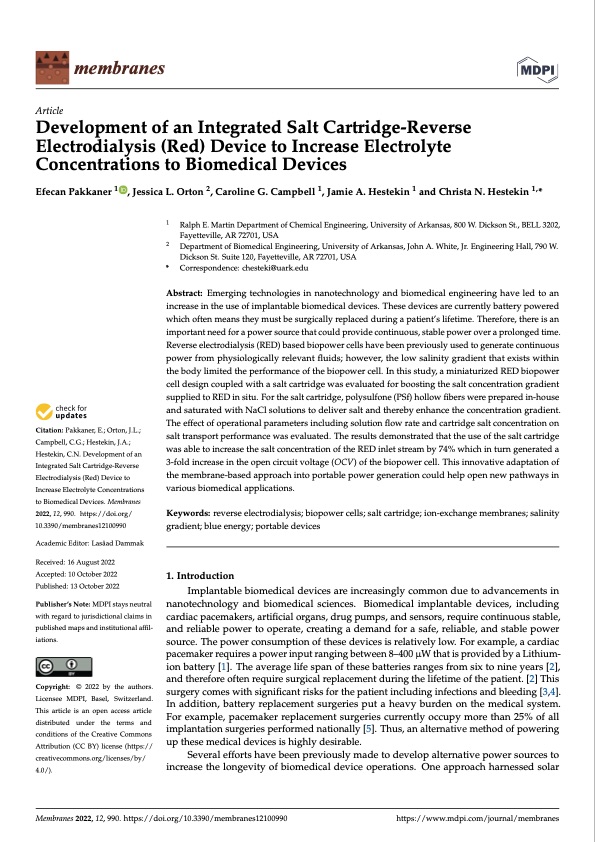
PDF Publication Title:
Text from PDF Page: 001
membranes Article Development of an Integrated Salt Cartridge-Reverse Electrodialysis (Red) Device to Increase Electrolyte Concentrations to Biomedical Devices Efecan Pakkaner 1 , Jessica L. Orton 2, Caroline G. Campbell 1, Jamie A. Hestekin 1 and Christa N. Hestekin 1,* 1 2 * Correspondence: chesteki@uark.edu Abstract: Emerging technologies in nanotechnology and biomedical engineering have led to an increase in the use of implantable biomedical devices. These devices are currently battery powered which often means they must be surgically replaced during a patient’s lifetime. Therefore, there is an important need for a power source that could provide continuous, stable power over a prolonged time. Reverse electrodialysis (RED) based biopower cells have been previously used to generate continuous power from physiologically relevant fluids; however, the low salinity gradient that exists within the body limited the performance of the biopower cell. In this study, a miniaturized RED biopower cell design coupled with a salt cartridge was evaluated for boosting the salt concentration gradient supplied to RED in situ. For the salt cartridge, polysulfone (PSf) hollow fibers were prepared in-house and saturated with NaCl solutions to deliver salt and thereby enhance the concentration gradient. The effect of operational parameters including solution flow rate and cartridge salt concentration on salt transport performance was evaluated. The results demonstrated that the use of the salt cartridge was able to increase the salt concentration of the RED inlet stream by 74% which in turn generated a 3-fold increase in the open circuit voltage (OCV) of the biopower cell. This innovative adaptation of the membrane-based approach into portable power generation could help open new pathways in various biomedical applications. Keywords: reverse electrodialysis; biopower cells; salt cartridge; ion-exchange membranes; salinity gradient; blue energy; portable devices 1. Introduction Implantable biomedical devices are increasingly common due to advancements in nanotechnology and biomedical sciences. Biomedical implantable devices, including cardiac pacemakers, artificial organs, drug pumps, and sensors, require continuous stable, and reliable power to operate, creating a demand for a safe, reliable, and stable power source. The power consumption of these devices is relatively low. For example, a cardiac pacemaker requires a power input ranging between 8–400 μW that is provided by a Lithium- ion battery [1]. The average life span of these batteries ranges from six to nine years [2], and therefore often require surgical replacement during the lifetime of the patient. [2] This surgery comes with significant risks for the patient including infections and bleeding [3,4]. In addition, battery replacement surgeries put a heavy burden on the medical system. For example, pacemaker replacement surgeries currently occupy more than 25% of all implantation surgeries performed nationally [5]. Thus, an alternative method of powering up these medical devices is highly desirable. Several efforts have been previously made to develop alternative power sources to increase the longevity of biomedical device operations. One approach harnessed solar Ralph E. Martin Department of Chemical Engineering, University of Arkansas, 800 W. Dickson St., BELL 3202, Fayetteville, AR 72701, USA Department of Biomedical Engineering, University of Arkansas, John A. White, Jr. Engineering Hall, 790 W. Dickson St. Suite 120, Fayetteville, AR 72701, USA Citation: Pakkaner, E.; Orton, J.L.; Campbell, C.G.; Hestekin, J.A.; Hestekin, C.N. Development of an Integrated Salt Cartridge-Reverse Electrodialysis (Red) Device to Increase Electrolyte Concentrations to Biomedical Devices. Membranes 2022,12,990. https://doi.org/ 10.3390/membranes12100990 Academic Editor: Lasâad Dammak Received: 16 August 2022 Accepted: 10 October 2022 Published: 13 October 2022 Publisher’s Note: MDPI stays neutral with regard to jurisdictional claims in published maps and institutional affil- iations. Copyright: © 2022 by the authors. Licensee MDPI, Basel, Switzerland. This article is an open access article distributed under the terms and conditions of the Creative Commons Attribution (CC BY) license (https:// creativecommons.org/licenses/by/ 4.0/). Membranes 2022, 12, 990. https://doi.org/10.3390/membranes12100990 https://www.mdpi.com/journal/membranesPDF Image | Integrated Salt Cartridge-Reverse Electrodialysis

PDF Search Title:
Integrated Salt Cartridge-Reverse ElectrodialysisOriginal File Name Searched:
membranes-12-00990.pdfDIY PDF Search: Google It | Yahoo | Bing
Product and Development Focus for Salgenx
Redox Flow Battery Technology: With the advent of the new USA tax credits for producing and selling batteries ($35/kW) we are focussing on a simple flow battery using shipping containers as the modular electrolyte storage units with tax credits up to $140,000 per system. Our main focus is on the salt battery. This battery can be used for both thermal and electrical storage applications. We call it the Cogeneration Battery or Cogen Battery. One project is converting salt (brine) based water conditioners to simultaneously produce power. In addition, there are many opportunities to extract Lithium from brine (salt lakes, groundwater, and producer water).Salt water or brine are huge sources for lithium. Most of the worlds lithium is acquired from a brine source. It's even in seawater in a low concentration. Brine is also a byproduct of huge powerplants, which can now use that as an electrolyte and a huge flow battery (which allows storage at the source).We welcome any business and equipment inquiries, as well as licensing our flow battery manufacturing.| CONTACT TEL: 608-238-6001 Email: greg@salgenx.com | RSS | AMP |